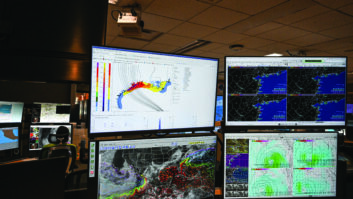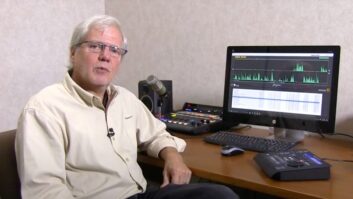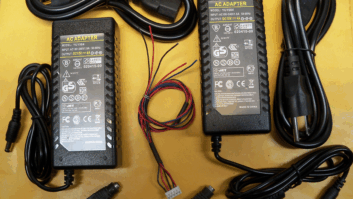The holiday period is a tough one for getting major projects done. There are the scheduled days off, of course. There are also the many unplanned days when colleagues take off to do something other than work. There are also weather considerations, of course. Still, some of us man the store for the duration of the season.
So what are some ways to be productive during this season — ones that will pay dividends as soon as January rolls around? Here are some productive housekeeping items that make your job easier.
TECHNICAL WORKSTATIONS
I recommend keeping your administrative space and your workbench separate, to the extent possible (and assuming the space exists). This is especially true if your administrative space is amongst other department heads at the radio station.

In fact, the ideal situation is this: have the department heads who know you as an administrator see you doing work in front of your computer (working on spreadsheets and the like). This would include the GM, the sales manager, and business manager. Likewise, the department heads who know you as the guy who responds to technical issues should see you hunched over a soldering iron; locate your workbench space somewhere near the studios.
A workbench that is designed for the analysis and repair of electronics is no luxury at the station. If your job is fixing electronics, the workbench is just as important as other tools, like your computer. The right tools are always needed for the job, and the correct workspace is one of those.
Here are some of the more important features you should consider when picking your workbench:
Resilient countertop. The last thing you want is to have a piece of rackmount gear, or a computer chassis score or otherwise mar the countertop on day one. A butcher-block style would be ideal in the event you don’t care about divots; on the other hand, if you do, you could always cover the top with something like Masonite.
Adjustable height. Ergonomics are very important. I usually opt for a slightly higher work surface and slightly lower chair, because this keeps my back straighter, hopefully preventing soreness later on. If your workstation countertop is too low, your back will grow tired before long.
Shelf space. Some of your test equipment belongs at eye level, above the primary counter top. Get a shelf for items such as voltmeters, oscilloscopes, and audio meters. Save the primary countertop space for the item(s) you are currently working on.

Electrical outlets. Clearly the shelf is going to need access to electricity if you load test equipment on top of it. I prefer outlets to be on the back of the shelf. If they are in front, before you know it, power cords will be in the way.
Magnifying lamp. The reality of getting older is that you need more light to see what you are doing as time goes on, and magnification can be especially vital when working on electronics. If you do get a new workstation, see about a magnifying lamp at the same time.
As in so many cases, Amazon is a good website to see what electronics workstations are available and to easily compare pricing between models.
If you have seen factories or other locations where a lot of soldering is done, you know that the smoke is very deliberately removed from the area. (Here’s a good Youtube video on the negative effects of solder smoke, in case you need extra motivation.)
There are quite a few fan/filter combination devices that can be used to keep solder smoke from circulating in the air around the shop. As just one example, you could consider the Aoyue 486 Benchtop Solder Smoke Absorber. It’s quite inexpensive, coming in at less than $50.
MOST VITAL TEST EQUIPMENT
“If I were stranded on a desert island, what would be the one piece of test equipment I would need…” If I were to answer, it would be portable digital multimeter. There’s more to a well-equipped shop than that, though.

DMM. Probably the most important feature of a digital multimeter is its ohmmeter. After all, how many problems boil down to a bad connection? Many. Secondly, a DMM’s AC and DC voltmeter functionality comes in second. Measuring current flow is something you may do while troubleshooting — its use is fairly rare. Other features are marketing. Stick with well-known brands (Fluke comes to mind) and don’t cheap out. This isn’t something you want to buy at hardware or auto parts store.
Audio signal generator. You’ll want both AES and analog outputs. Analog outputs should go as high as you can get them — +24 dBu would be ideal.
Audio metering. A set of actual VU meters is extremely important to have at the station. The Coleman Audio MBP2 is one of the few units out there — stereo meters, switchable between +4 and + 10 dBu, with XLR inputs.
Variable power supply. Troubleshooting power supplies is a task in which you should be competent. It’s the one part of every device most likely to fail. Having a variable bench power supply allows you to isolate a potentially bad power supply and substitute a known-good power supply as part of the process. Voltage and current capacity are the parameters you’ll be paying for: Get a variable, dual-polarity output (at least 0-15 VDC) as well as a 0-24 VDC output with 5A of capacity. (You may need two separate devices.)
Layer-2 switch. You will often have a piece of gear on your bench that needs configuration, or some attention, best applied via Ethernet. Outfit yourself with a small layer-2 (Ethernet) switch for just those occasions.
PORTABILITY IS KEY
In our October 2015 issue, I mentioned other inexpensive pieces of test equipment that use a laptop as their base —including an oscilloscope and spectrum analyzer. You may want you to look back at that issue; you can read it here.

I can’t imagine not having some sort of computer in the shop, but a laptop and Wi-Fi is often more useful than a desktop for any number of reasons. For example, you can:
Look at user manuals online while standing in front of a piece of newly racked up equipment.
Run the user interface of a piece of gear while standing in front of the equipment itself.
Configuration of the new device via its user interface.
Install an audio recording program, such as Audacity. This can be a great troubleshooting tool, if you pick up an inexpensive audio-to-USB converter as part of your test equipment.
Serial-data connection testing, using PuTTY or CoolTerm. Pick up an inexpensive serial-to-USB converter to facilitate this sort of testing, unless your laptop still has a serial port built-in.
Sure, you can do much of that with a PC in the shop, but do you really want to run back and forth between there and the rack-room, if they aren’t colocated? Not every problem is analyzed and/or fixed in your usual work area. You could be doing work in a studio, a hallway, or in the rack-room. For this reason, portability is key.
And every shop needs a place to keep and organize tools, of course.
Usually this is accomplished with a toolbox of some sort — often one you would see in a mechanic’s garage. I recommend that you use a roll-around toolbox, one that can easily be pushed out from your workstation to wherever you need it around the station. How annoying is it to continually get up and go back to the shop to grab more tools? (Very.) This type of case is designed to minimize all that back-and-forth.
It’s easy to stock the toolbox with 95% of the items you use on a regular basis — cutters, screwdrivers, keys, as well as materials. My roll-around has the usual hand tools, along with the test cables I use for the vast majority of work.
I have also found having a butcher-block on top of the roll-around is very helpful, so that you have a space to set your work as necessary.
A variation on this idea is a workbench on wheels. You’ll need a place to set the computer, too, unless you don’t mind sitting it on the floor all of the time. You can also use the horizontal space to hold other test equipment, and items meant for a horizontal surface, such as a soldering iron and vise. I also suggest you install some sort of AC power strip to this roll-around, so that all the various items can be accommodated for their power needs.
If you want to get more work done in the same amount of time (especially if you want to stick to a 40-hour work week), then workflow is an important consideration. These ideas are meant to make your work flow more smoothly, which should lead to an increase in productivity, and a decrease in frustration.







